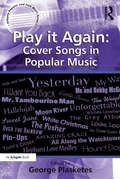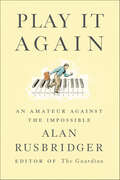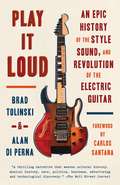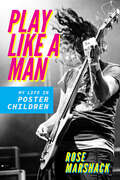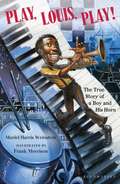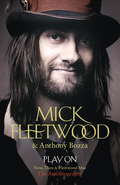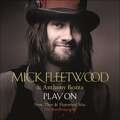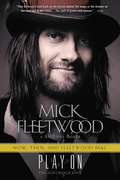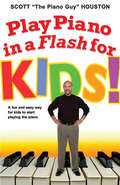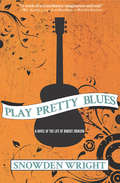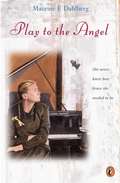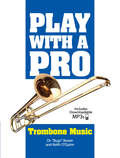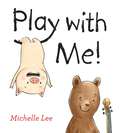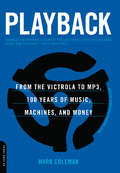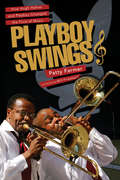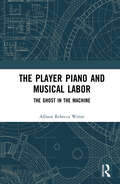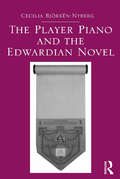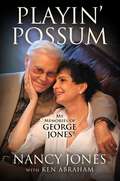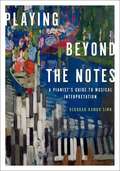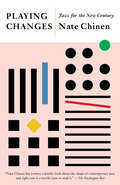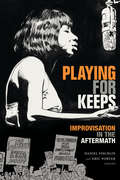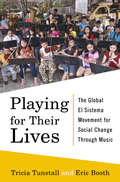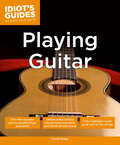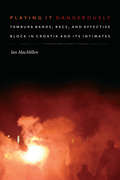- Table View
- List View
Play it Again: Cover Songs In Popular Music (Ashgate Popular and Folk Music Series)
by George PlasketesCovering”the musical practice of one artist recording or performing another composer's song”has always been an attribute of popular music. In 2009, the internet database Second Hand Songs estimated that there are 40,000 songs with at least one cover version. Some of the more common variations of this "appropriationist" method of musical quotation include traditional forms such as patriotic anthems, religious hymns such as Amazing Grace, Muzak's instrumental interpretations, Christmas classics, and children's songs. Novelty and comedy collections from parodists such as Weird Al Yankovic also align in the cover category, as does the "larcenous art" of sampling, and technological variations in dance remixes and mash-ups. Film and television soundtracks and advertisers increasingly rely on versions of familiar pop tunes to assist in marketing their narratives and products. The cover phenomenon in popular culture may be viewed as a postmodern manifestation in music as artists revisit, reinterpret and re-examine a significant cross section of musical styles, periods, genres, individual records, and other artists and their catalogues of works.The cover complex, with its multiple variations, issues, contexts, and re-contextualizations comprises an important and rich popular culture text. These re-recordings represent artifacts which embody artistic, social, cultural, historical, commercial, biographical, and novel meanings. Through homage, allusion, apprenticeship, and parody, among other modes, these diverse musical quotations express, preserve, and distribute popular culture, popular music and their intersecting historical narratives. Play it Again represents the first collection of critical perspectives on the many facets of cover songs in popular music.
Play It Again: An Amateur Against the Impossible
by Alan RusbridgerAs editor of the Guardian, one of the world's foremost newspapers, Alan Rusbridger abides by the relentless twenty-four-hour news cycle. But increasingly in midlife, he feels the gravitational pull of music—especially the piano. He sets himself a formidable challenge: to fluently learnChopin's magnificent Ballade No. 1 in G minor, arguably one of the most difficult Romantic compositions in the repertory. With pyrotechnic passages that require feats of memory, dexterity, and power, the piece is one that causes alarm even in battle-hardened concert pianists. He gives himself a year.Under ideal circumstances, this would have been a daunting task. But the particular year Rusbridger chooses turns out to be one of frenetic intensity. As he writes in his introduction, "Perhaps if I'd known then what else would soon be happening in my day job, I might have had second thoughts. For it would transpire that, at the same time, I would be steering the Guardian through one of the most dramatic years in its history." It was a year that began with WikiLeaks' massive dump of state secrets and ended with the Guardian's revelations about widespread phone hacking at News of the World. "In between, there were the Japanese tsunami, the Arab Spring, the English riots . . . and the death of Osama Bin Laden," writes Rusbridger. The test would be to "nibble out" twenty minutes per day to do something totally unrelated to the above.Rusbridger's description of mastering the Ballade is hugely engaging, yet his subject is clearly larger than any one piece of classical music. Play It Again deals with focus, discipline, and desire but is, above all, about the sanctity of one's inner life in a world dominated by deadlines and distractions.What will you do with your twenty minutes?
Play It Loud: An Epic History of the Style, Sound, and Revolution of the Electric Guitar
by Alan Di Perna Brad Tolinski Carlos SantanaBy the longtime editor-in-chief of Guitar World and a veteran rock journalist, an unprecedented history of the electric guitar, its explosive impact on music and culture, and the people who brought it to life.Spanning a century and encompassing some of guitar's greatest builders and players, from Les Paul to Keith Richards to Eddie Van Halen, Brad Tolinski and Alan di Perna bring the evolution of the guitar to roaring life. This is a story of inventors and iconoclasts, of scam artists, prodigies and mythologizers, as varied and original as the music they spawned. Play It Loud uses twelve landmark instruments, each of them a milestone in the progress of the electric guitar, to illustrate the chaos, conflict and passion it has inspired. It introduces Leo Fender, a man who couldn't play a note, but whose innovation helped transform the classical guitar into the explosive sound machine it is today. Some of the most significant social movements of the 20th century are indebted to the guitar: it was an essential part of Beatlemania and Woodstock; a mirror to the rise of the teenager as a social force; a linchpin of the punk movement's sound and ethos. And today the guitar has come full circle, with contemporary titans such as Jack White of The White Stripes and Dan Auerbach of The Black Keys bringing some of those earliest electric guitar forms back to the limelight. For generations, the electric guitar has been an international symbol of freedom, danger and hedonism. Play It Loud is the story of how a band of innovators transformed a simple notion into a singular cultural force.
Play It Loud: An Epic History of the Style, Sound, and Revolution of the Electric Guitar
by Brad Tolinski Carlos Santana Alan Di PernaAn unprecedented history of the electric guitar, its explosive impact on music and culture, and the players and builders who brought it to life For generations the electric guitar has been an international symbol of freedom, danger, rebellion, and hedonism. In Play It Loud, veteran music journalists Brad Tolinski and Alan di Perna bring the history of this iconic instrument to roaring life. It's a story of inventors and iconoclasts, of scam artists, prodigies, and mythologizers as varied and original as the instruments they spawned.Play It Loud uses twelve landmark guitars--each of them artistic milestones in their own right--to illustrate the conflict and passion the instruments have inspired. It introduces Leo Fender, a man who couldn't play a note but whose innovations helped transform the guitar into the explosive sound machine it is today. Some of the most significant social movements of the twentieth century are indebted to the guitar: It was an essential element in the fight for racial equality in the entertainment industry; a mirror to the rise of the teenager as social force; a linchpin of punk's sound and ethos. And today the guitar has come full circle, with contemporary titans such as Jack White of The White Stripes, Annie Clark (aka St. Vincent), and Dan Auerbach of The Black Keys bringing some of the earliest electric guitar forms back to the limelight.Featuring interviews with Les Paul, Keith Richards, Carlos Santana, Eddie Van Halen, Steve Vai, and dozens more players and creators, Play It Loud is the story of how a band of innovators transformed an idea into a revolution.From the Hardcover edition.
Play Like a Man: My Life in Poster Children (Music in American Life)
by Rose MarshackAs a member of Poster Children, Rose Marshack took part in entwined revolutions. Marshack and other women seized a much-elevated profile in music during the indie rock breakthrough while the advent of new digital technologies transformed the recording and marketing of music. Touring in a van, meeting your idols, juggling a programming job with music, keeping control and credibility, the perils of an independent record label (and the greater perils of a major)—Marshack chronicles the band’s day-to-day life and punctuates her account with excerpts from her tour reports and hard-learned lessons on how to rock, program, and teach while female. She also details the ways Poster Children applied punk’s DIY ethos to digital tech as a way to connect with fans via then-new media like pkids listservs, internet radio, and enhanced CDs. An inside look at a scene and a career, Play Like a Man is the evocative and humorous tale of one woman’s life in the trenches and online.
Play, Louis, Play!: The True Story of a Boy and his Horn
by Muriel Harris WeinsteinThe book delivers a rollicking biography of jazz great Louis Armstrong's childhood, told from the perspective of his dearest companion--his horn.
Play On: Now, Then and Fleetwood Mac
by Mick Fleetwood"After forty-six years of being on the road, now is the right time to look back in a way I've never done before: now and then. I'm looking forward to sharing it with you." Mick Fleetwood has been part of one of the world's most successful and adored bands for over four decades. Here he tells the full and candid story of that life, and what it is to be part of the ever evolving Fleetwood Mac. His all-access autobiography spans the career of one of classic rock's greatest drummers and band leaders, the co-founder of the deeply loved super group that bears his name. In this intimate portrait of a life lived in music, Fleetwood vividly recalls his upbringing in Cornwall, Egypt and Norway tapping along to whatever song was playing on the radio; his experiences as a musician in Sixties London; the early days of the band featuring Peter Green, and his close friendship with George Harrison and seemingly all of music royalty. Play On sheds new light on Fleetwood Mac's raucous history describing the highs and lows of being part of a band that he often single-handedly kept together. His love affair with Stevie Nicks, the creation of landmark albums like Rumours and Tusk, and the many incredible and outrageous moments of recording, touring, fighting, and loving with Fleetwood Mac: all are here. He describes his life's moments with the honesty and immediacy that his fans expect, taking us to the very heart of this multi layered life. It's been a tumultuous journey with the excesses of the band's huge success at times threatening to destroy what they strived so hard to create. But through it all it's been the drive to play on that has won out. Now, then, and always, it's Fleetwood Mac.
Play On: Now, Then and Fleetwood Mac
by Mick Fleetwood"After forty-six years of being on the road, now is the right time to look back in a way I've never done before: now and then. I'm looking forward to sharing it with you." Mick Fleetwood has been part of one of the world's most successful and adored bands for over four decades. Here he tells the full and candid story of that life, and what it is to be part of the ever evolving Fleetwood Mac. His all-access autobiography spans the career of one of classic rock's greatest drummers and band leaders, the co-founder of the deeply loved super group that bears his name. In this intimate portrait of a life lived in music, Fleetwood vividly recalls his upbringing in Cornwall, Egypt and Norway tapping along to whatever song was playing on the radio; his experiences as a musician in Sixties London; the early days of the band featuring Peter Green, and his close friendship with George Harrison and seemingly all of music royalty. Play On sheds new light on Fleetwood Mac's raucous history describing the highs and lows of being part of a band that he often single-handedly kept together. His love affair with Stevie Nicks, the creation of landmark albums like Rumours and Tusk, and the many incredible and outrageous moments of recording, touring, fighting, and loving with Fleetwood Mac: all are here. He describes his life's moments with the honesty and immediacy that his fans expect, taking us to the very heart of this multi layered life. It's been a tumultuous journey with the excesses of the band's huge success at times threatening to destroy what they strived so hard to create. But through it all it's been the drive to play on that has won out. Now, then, and always, it's Fleetwood Mac.(P)2014 Hodder & Stoughton
Play On: Now, Then, and Fleetwood Mac: The Autobiography
by Mick Fleetwood Anthony BozzaMick Fleetwood, the drummer and cofounder of the mega-selling band Fleetwood Mac, tells all.In this candid, intimate portrait of a life lived in music, Mick Fleetwood sheds new light on well-known points in his history, including many incredible moments of recording and touring with Fleetwood Mac, as well as personal insights from a man who has been a major player in blues and rock n' roll since his teens.The group Fleetwood Mac has sold over 140 million records worldwide, and they continue to attract a huge following, selling out their biggest arena tour ever in 2013, decades after their debut. Finally, the group's admirers will have a unique portrait of what made Mick and the rest of the group tick in the midst of their massive success and personal trials.
Play Piano in a Flash for Kids!: A Fun and Easy Way for Kids to Start Playing the Piano
by Scott HoustonGetting a child to play piano has never been easier!As seen on public television nationwide, Scott "The Piano Guy" Houston is the leading authority on fast and fun piano instruction. In Play Piano in a Flash for Kids! he simplifies his unique and effective method of learning to play piano, making it accessible to even the youngest want-to-be pianists. Highlighting popular, not classical, music, this book fosters and nourishes an early love for music by giving children the tools to play their favorite popular songs.Your child will be able to: Learn the basics of piano playing using a simple technique that pros use, which focuses on becoming a good player versus becoming a good notation reader Use easy-to-follow step-by-step illustrations that demonstrate each stage of learning Play popular music on the piano without having to learn how to read complicated sheet musicIt is a great book for kids who may have taken lessons previously but became frustrated by the long and complicated process. And all at a fraction of the cost of piano lessons!Both parents and children can have fun learning the piano or keyboard together, or children can work through the book on their own, with parents providing support only when needed. Play Piano in a Flash for Kids! is the perfect tool for parents or teachers to help their kids learn to play the piano quickly and easily.
Play Pretty Blues
by Snowden WrightThe mysteries of blues legend Robert Johnson's live and death long ago became myth. Part researched reconstruction, part vivid imagination, this lyrical novel brings Johnson alive through the voices of his six wives, revealing the husband and son inside the legend, illuminating the vacuum Johnson left in the worlds of those who loved him and those he would never meet.
Play to the Angel
by Maurine F. DahlbergAustria in 1938 is under the shadow of the Nazis, but 12-year-old Greta doesn't notice--she cares only for her piano lessons with their new neighbor. Then the Nazis invade and Greta discovers her teacher's secret. His life is in danger, and she may be the only one who can help him.
Play with a Pro: Trombone Music
by Keith O'Quinn Dr Bugs BowerFrom Dixieland and boogie woogie to swing, blues, jazz, bop, Latin, and rock music, this title offers a variety of styles. Along with music to fifteen songs, downloadable MP3s provide a chance to play with a top Broadway trombonist.Each song is recorded three ways:1. Practice playing melody (1st trombone) or harmony (2nd trombone) with the title tracks, MP3s 1-15, marked TT.2. Practice playing melody (1st trombone) with accompaniment, MP3s 16-30, marked MT. 3. Practice playing harmony (2nd trombone) with accompaniment, MP3s 31-45, marked HT.These rehearsal routines are comparable to playing a 25-minute set with a live stage band!
Play with Me!
by Michelle LeePlaytime means very different things to these two spirited friendsPip is full of ideas for what to play: Dress up! Magicians! Dolls! Only, Nico doesn&’t want to play any of them, and Pip gets mad. REALLY mad. But don&’t worry—Nico finds the perfect way for them to play together. Michelle Lee&’s irresistible characters show that finding a way to play together will always hit the right note.
Playback: From the Victrola to MP3, 100 Years of Music, Machines, and Money
by Mark ColemanPlayback is the first book to place the fascinating history of sound reproduction within its larger social, economic, and cultural context-and includes appearances by everyone from Thomas Edison to En
Playboy Swings: How Hugh Hefner and Playboy Changed the Face of Music
by Patty Farmer Will FriedwaldPlayboy—the magazine, the empire, the lifestyle—is one of the world’s best-known brands. Since the launch of Playboy magazine in 1953, two elements have been remarkably consistent: the first, obviously, is the celebration of nubile, female flesh. The second, readers may be surprised to learn, is Playboy’s involvement in the music scene. The Playboy experience was never just about sex but about lifestyle. Music—particularly the finest jazz, a personal passion of Hefner’s—has always been an essential component of that lifestyle. Playboy Swings focuses specifically on Playboy’s involvement in the music scene, its impact on popular entertainment (and vice versa), and the fabulous cadre of performers who took to the stages of the mythic Playboy Clubs and Jazz Festivals. Throughout Playboy Swings, Farmer demonstrates how Playboy helped change the world through music by integrating the TV shows, festivals, and the clubs.Complied through interviews with hundreds of people who were on the scene throughout Playboy’s rise, fall, and on-going renaissance, Playboy Swings carries readers on a seductive journey through the history of the empire—all the while focusing on the musical entertainment that made it unique. Hef’s personal passion for music—and his belief in it as a cornerstone of the Playboy ethos—has expressed itself in a wide range of media over Playboy’s 60-year history, and all of it comes alive in these pages. Famer takes the reader from the inception of the Playboy empire through the 1959 jazz festival, to the opening of club after club.With approximately 60 black and white photos, and a complete Playboy music reference guide, readers will think of music, not just Bunnies, when thinking about Playboy.Throughout the book, it is the artists who do most of the talking—and they have a lot to say about the golden era of Playboy entertainment.
The Player Piano and Musical Labor: The Ghost in the Machine
by Allison Rebecca WenteBy the early 20th century the machine aesthetic was a well-established and dominant interest that fundamentally transformed musical performance and listening practices. While numerous scholars have examined this aesthetic in art and literature, musical compositions representing industrialized labor practices and the role of the machine in music remain largely unexplored. Moreover, in recounting the history of machines in musical recording and reproduction, scholars often tend to emphasize the phonograph, rather than player piano, despite the latter’s prominence within the newly established musical marketplace. Machines and their music influenced multiple areas of early 20th-century musical culture, from film scores to popular music and even the concert hall. But the opposite was also true: industrialized labor practices changed the musical marketplace and musical culture as a whole. As consumers accepted mechanical replacements for what previously required an active human laborer, ghostly, mechanical performers labored tirelessly in parlors, businesses, and even concert halls. Although the player piano failed to maintain a stronghold in the recorded music marketplace after 1930, the widespread acceptance of recording technologies as media for storing and enjoying music indicates a much more fundamental societal shift. This book explores that shift, examining the rise and fall of the player piano in early 20th-century society and connecting it to the digital technologies of today.
The Player Piano and the Edwardian Novel
by Cecilia Bjorken-NybergIn her study of music-making in the Edwardian novel, Cecilia Bjorkén-Nyberg argues that the invention and development of the player piano had a significant effect on the perception, performance and appreciation of music during the period. In contrast to existing devices for producing music mechanically such as the phonograph and gramophone, the player piano granted its operator freedom of individual expression by permitting the performer to modify the tempo. Because the traditional piano was the undisputed altar of domestic and highly gendered music-making, Bjorkén-Nyberg suggests, the potential for intervention by the mechanical piano's operator had a subversive effect on traditional notions about the status of the musical work itself and about the people who were variously defined by their relationship to it. <P><P> She examines works by Dorothy Richardson, E.M. Forster, Henry Handel Richardson, Max Beerbohm and Compton Mackenzie, among others, contending that Edwardian fiction with music as a subject undermined the prevalent antithesis, expressed in contemporary music literature, between a nineteenth-century conception of music as a means of transcendence and the increasing mechanisation of music as represented by the player piano. Her timely survey of the player piano in the context of Edwardian commercial and technical discourse draws on a rich array of archival materials to shed new light on the historically conditioned activity of music-making in early twentieth-century fiction.
Playin' Possum: My Memories of George Jones
by Nancy JonesIn Playin' Possum, readers get an intimate look at country music legend George Jones through the eyes of his wife of thirty years.Ask anyone who knows country music, &“Who was the GOAT—the greatest of all time?&” and the answers will inevitably lead to George Jones. Millions of people know the name of the iconic country music artist, George Jones, but few people know that behind the man and his golden voice was a strong, feisty woman who not only saved his life from cocaine addiction, alcoholism, and other abusive and self-destructive behaviors, but also was instrumental in saving his soul. Legends, half-truths, and downright lies abound about the iconic singer, but what secrets do people not know about him? What was it like to live with him through the darkest shadows and in the brightest of lights? Married for more than thirty years to the greatest country music singer who ever lived, the man Frank Sinatra had whimsically referred to as &“the second-greatest singer in America,&” Nancy Jones knew George Jones better than anyone else on earth—the good George and the bad George, the horrendous, and the hilarious. George and Nancy married March 4, 1983, and with her help and encouragement, he quit his wild and wicked ways—for a while. Nancy soon learned, however, that the demons held a strong grip on the man she loved, and they were not about to release him without a fight. But Nancy Jones is a tenacious fighter, and most people who knew &“the Possum,&” credit Nancy with saving his life and rebuilding his career. For the first time, in Playin' Possum, Nancy Jones reveals the true &“insider&” perspectives and little known poignant and as well as humorous stories about the country music icon—his battles with cocaine, alcohol, abusive behavior toward her and others, his battles with himself, and most of all, his battles against the demons that sought to control him and ultimately destroy him. Nancy knew there was a good man inside George Jones, and she felt strongly that God had given her the assignment to help him, even if he hurt her. She refused to give up on Jones. Although Tammy Wynette sang &“Stand By Your Man,&” it was actually Nancy Jones who stood by George for more than thirty years, and helped bring him to the Light. Together, they brought joy and light to millions of people.
Playing Beyond The Notes: A Pianist's Guide to Musical Interpretation
by Deborah Rambo SinnThis book demystifies the complex topic of musical interpretation by boiling it down to basic principles in an accessible writing style. The book targets pianists, piano teachers, and piano pedagogy students and incorporates over 200 musical examples from the intermediate and advanced piano repertoire.
Playing Changes: Jazz for the New Century
by Nate ChinenOne of jazz’s leading critics gives us an invigorating, richly detailed portrait of the artists and events that have shaped the music of our time. Grounded in authority and brimming with style, Playing Changes is the first book to take the measure of this exhilarating moment: it is a compelling argument for the resiliency of the art form and a rejoinder to any claims about its calcification or demise.“Playing changes,” in jazz parlance, has long referred to an improviser’s resourceful path through a chord progression. Playing Changes boldly expands on the idea, highlighting a host of significant changes—ideological, technological, theoretical, and practical—that jazz musicians have learned to navigate since the turn of the century. Nate Chinen, who has chronicled this evolution firsthand throughout his journalistic career, vividly sets the backdrop, charting the origins of jazz historicism and the rise of an institutional framework for the music. He traces the influence of commercialized jazz education and reflects on the implications of a globalized jazz ecology. He unpacks the synergies between jazz and postmillennial hip-hop and R&B, illuminating an emergent rhythm signature for the music. And he shows how a new generation of shape-shifting elders, including Wayne Shorter and Henry Threadgill, have moved the aesthetic center of the music. Woven throughout the book is a vibrant cast of characters—from the saxophonists Steve Coleman and Kamasi Washington to the pianists Jason Moran and Vijay Iyer to the bassist and singer Esperanza Spalding—who have exerted an important influence on the scene. This is an adaptive new music for a complex new reality, and Playing Changes is the definitive guide.
Playing for Keeps: Improvisation in the Aftermath (Improvisation, Community, and Social Practice)
by Daniel Fischlin Eric PorterThe contributors to Playing for Keeps examine the ways in which musical improvisation can serve as a method for negotiating violence, trauma, systemic inequality, and the aftermaths of war and colonialism. Outlining the relation of improvisatory practices to local and global power structures, they show how in sites as varied as South Africa, Canada, Egypt, the United States, and the Canary Islands, improvisation provides the means for its participants to address the past and imagine the future. In addition to essays, the volume features a poem by saxophonist Matana Roberts, an interview with pianist Vijay Iyer about his work with U.S. veterans of color, and drawings by artist Randy DuBurke that chart Nina Simone's politicization. Throughout, the contributors illustrate how improvisation functions as a model for political, cultural, and ethical dialogue and action that can foster the creation of alternate modes of being and knowing in the world.Contributors. Randy DuBurke, Rana El Kadi, Kevin Fellezs, Daniel Fischlin, Kate Galloway, Reem Abdul Hadi, Vijay Iyer, Mark Lomanno, Moshe Morad, Eric Porter, Sara Ramshaw, Matana Roberts, Darci Sprengel, Paul Stapleton, Odeh Turjman, Stephanie Vos
Playing for Their Lives: The Global El Sistema Movement for Social Change Through Music
by Eric Booth Tricia TunstallAn eye-opening view of the unprecedented global spread of El Sistema--intensive music education that disrupts the cycles of poverty. In some of the bleakest corners of the world, an unprecedented movement is taking root. From the favelas of Brazil to the Maori villages in New Zealand, from occupied Palestine to South Central Los Angeles, musicians with strong social consciences are founding intensive orchestra programs for children in need. In this captivating and inspiring account, authors Tricia Tunstall and Eric Booth tell the remarkable story of the international El Sistema movement. A program that started over four decades ago with a handful of music students in a parking garage in Caracas, El Sistema has evolved into one of classical music's most vibrant new expressions and one of the world's most promising social initiatives. Now with more than 700,000 students in Venezuela, El Sistema's central message--that music can be a powerful tool for social change--has burst borders to grow in 64 countries (and that number increases steadily) across the globe. To discover what makes this movement successful across the radically different cultures that have embraced it, the authors traveled to 25 countries, where they discovered programs thriving even in communities ravaged by poverty, violence, or political unrest. At the heart of each program is a deep commitment to inclusivity. There are no auditions or entry costs, so El Sistema's doors are open to any child who wants to learn music--or simply needs a place to belong. While intensive music-making may seem an unlikely solution to intractable poverty, this book bears witness to a program that is producing tangible changes in the lives of children and their communities. The authors conclude with a compelling and practicable call to action, highlighting civic and corporate collaborations that have proven successful in communities around the world.
Playing Guitar (Idiot's Guides)
by David HodgeLearning to play the guitar has never been easier! Idiot&’s Guides®: Playing Guitar begins with an introduction to different types of guitars and their parts, followed by helpful information on how to choose a guitar. You&’ll learn how to tune the guitar (supplemented with online audio), how to correctly hold it, how to read tablature, and about basic rhythm. Much of the remainder of the book gives you easy-to-follow instructions on learning chords, and each lesson is followed by a fun practice session and a simple song with which to practice the newly learned chords. In addition to over-the-shoulder color photos showing fingering positions and accompanying two-color chord charts that show exactly what to do, you can hear the chords, exercises, and songs performed from additional content online.
Playing It Dangerously: Tambura Bands, Race, and Affective Block in Croatia and Its Intimates (Music / Culture)
by Ian MacMillenPlaying It Dangerously questions what happens when feelings attached to popular music conflict with expressions of the dominant socio-cultural order, and how this tension enters into the politics of popular culture at various levels of human interaction. Tambura is a genre-crossing performance practice centered on an eponymous stringed instrument, part of the mandolin family, that Roma, Croats, and Serbs adopted from Ottoman forces. The acclamation that one is a "dangerous player" connotes exceptional virtuosic improvisation and rapid finger technique and, as the highest praise that a musician can receive from his peers. Tambura has served as a site of both contestation and reconciliation since its propagation as Croatia's national instrument during the 1990s Yugoslav wars. New sensibilities of 'danger' and of race (for instance, 'Gypsiness') arose as Croatian bands reterritorialized musical milieus through the new state, reestablishing transnational performance networks with Croats abroad, and reclaiming demilitarized zones and churches as sites of patriotic performance after years of 'Yugoslavian control.' This study combines ethnographic fieldwork with archival research and music analysis to expound affective block: a theory of the dialectical dynamics between affective and discursive responses to differences in playing styles. A corrective to the scholarly stress on music scenes saturated with feeling, the book argues for affect's social regulation, showing how the blocking of dangerous intensities ultimately privileges constructions of tambura players as heroic male Croats, even as the music engenders diverse racial and gendered becomings.
